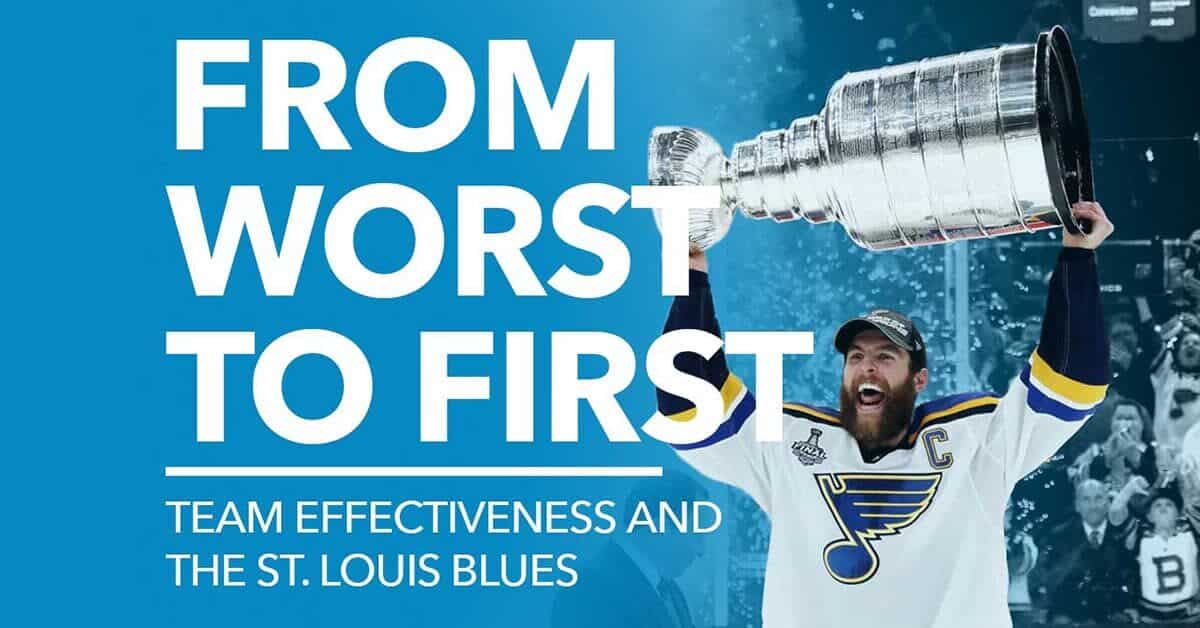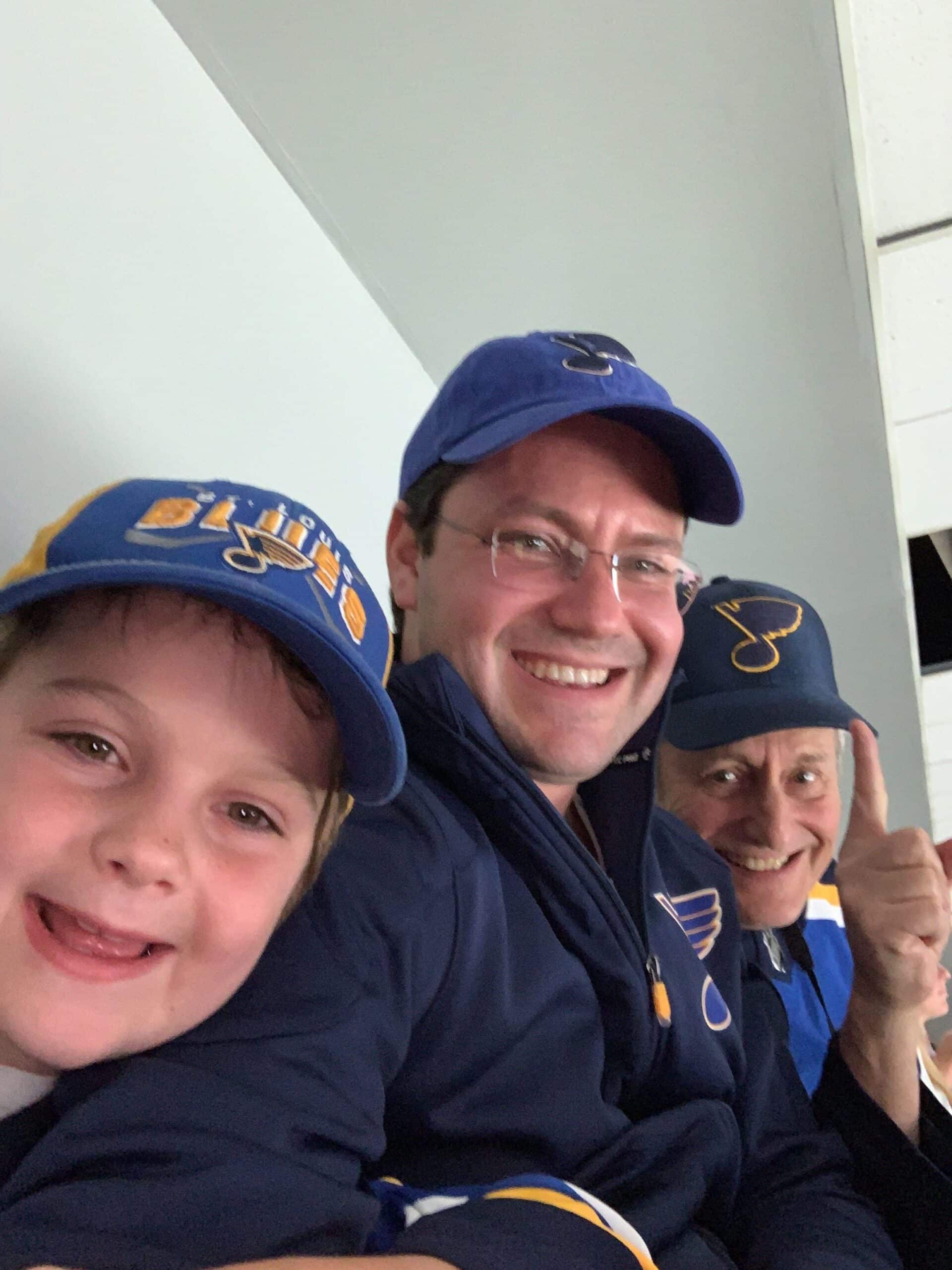
Worst to First: Learning About Team Effectiveness from the St. Louis Blues’ Cinderella Season
By AIIR Consulting | June 24, 2019
The Blues’ journey from last place was unprecedented in professional sports. Here are four lessons you can leverage from their historic win.
Growing up in St. Louis in the ’80s and ’90s, the Blues were the lifeblood of the city and yet, without fail, every year, they would either not make the playoffs or lose in round one. The consistency of the let-down, coupled with strong regular season play, engendered a melancholic relationship with the team. You loved the Blues, and yet, you expected them to lose.

I was no exception to this dynamic. As a child, I would regularly watch the Blues practice at the Brentwood ice-skating rink. After practice, I would dig through the dumpster at the back of the rink to find broken sticks and anything else I could bring home that was connected to my beloved team. I played ice hockey through high school (on AIIR coach Bob Kinnison’s rival team), inspired by my heroes. Meanwhile, the Blues would demonstrate their B-team dynamic year after year after year.
All of this would change, in an entirely unexpected way, this year.
After 49 years of B hockey, the St. Louis Blues took home the prized Stanley Cup, beating one of the league’s most talented teams, the Boston Bruins. The joy in St. Louis was a redemptive joy. I can attest to the enthusiasm, having traveled to St. Louis for game 4. Never has the city stopped and so pervasively celebrated a success.
The scene was surreal, especially considering how the season started.
For the first half of the season, the Blues were at the bottom of the 31-team National Hockey League. At a critical moment for the franchise, the Blues changed coaches, replacing Mike Yeo with former player Craig Berube – known more for punching people in the face during his prime years than any track record of coaching success. The team also brought a new goaltender up from the farm league. Jordan Binnington, a 24-year-old rookie, would be given a shot to play for one of the league’s worst teams.
This is where the magic started.
A Second “Miracle on Ice”
The second half of the year started off on a new note (pun intended). To the shock of St. Louis fans everywhere, the Blues started winning games. The Blues were starting to score and win. They turned things around so dramatically that they secured a spot in the playoffs.
As mentioned, the playoffs are not unfamiliar territory for the Blues. Their playbook has historically been to (1) make the playoffs, and then (2) lose in round one. How could this year be any different?
What hockey fans around the world witnessed was completely counter to the Blues’s historical precedent. The Blues became stronger after each game. It was not a single individual who carried the team, but rather collective performance.
Their passing game was incredible. Both the length of passes, the frequency of those passes, and the strategic nature of their passing game outperformed the defense of the opponent.
Wayne Gretzky, the greatest hockey player in history, was known for skating where the puck was going to be, rather than where the puck was. Doing so required coordination, predictive intelligence, and a degree of hockey-telepathy.
In the playoffs, the Blues embodied those same qualities. Each player seemed to know exactly where his teammates were going to be. The team’s grit and toughness were also remarkable. While the Blues experienced losses in all four series, they consistently bounced back and won the next game.
Lessons on Team Effectiveness
Close observation of the Blues’ playoff performance and subsequent Stanley Cup win revealed several distinct factors that contributed to their success. Moreover, these factors can be leveraged by organizations, both on and off the ice, to achieve spectacular results.
1. Team Effectiveness
We know from our research and practice that great teams require strong team culture and team productivity to outperform.
Team Culture
The Blues demonstrated an incredible culture – the manner in which team members interact with each other. In almost every interview of Blues players during the playoffs, player’s would point to their trust in each other and a feeling of unity (cohesion) that strengthened throughout the playoffs. We know that teams who demonstrate strong Team Culture also exhibit a “we before I” attitude. It’s about the team, not the individual. The fact that the Blues’s playoff star, Ryan O’Reilly, chose to play with a cracked rib is just one example of the sacrifice team players made for the greater whole.
Team Productivity
The Team also demonstrated exceptional Team Productivity – how effectively and efficiently they produced results. A key factor in Team Productivity is a concept called Alignment. Alignment describes how team members understand their purpose, establish shared goals and priorities, and assign clear ownership of those priorities.
In a corporate setting, we think of teams with high levels of alignment as a well-oiled machine. Work is engaged in an agile, fluid manner, with minimal friction or resistance. In hockey, you can tell if a team has strong alignment by their ability to stay disciplined about their positions and the effectiveness of their passing game.
2. Coaching
One of the main differences from the first half of the season to the second half was the team’s new coach – Craig Berube. Anyone who watched Craig Berube from the stands saw that he was truly an even-keeled leader who brought the Blues much-needed focus, discipline, and accountability for results. Is this not what we do as leader coaches and executive coaches?
3. Purpose
Listening to player interviews, it was clear that winning the Stanley Cup was far more than just getting a new ring and dancing on the ice with a silver trophy. The players talked about how the city of St. Louis needed to win the cup. Deserved to win the cup. How fans who have suffered generations of B hockey deserved better.
Even deeper than this, the Blues had a super-fan, Laila Anderson, an 11-year-old who suffers from hemophagocytic lymphohistiocytosis, a rare immune disorder. Laila was at every game and in many ways, winning the cup was winning for Laila. What’s the takeaway for us non-NHLers? Find your north star and align your activities and energy accordingly! The clearer we are about the purposefulness of our work, the more meaning we make, and the more meaning we make, the greater our output and sense of fulfillment will be.
4. Fun
Watching the playoffs was a blast, but hearing the song Gloria blasted over the loudspeakers was just weird. How did this song become the rallying cry for the St. Louis Blues?
It turns out that earlier in the year, several Blues players heard the 1982 Laura Branigan hit at a bar in Philadelphia and decided to play it as their celebration song after winning a game. The idiosyncratic nature of this song, coupled with NHL hockey in 2019, was hilarious to them. The next game they won, they played the song. So they continued. The players were having fun!
This brings us to our final point. High-performing teams who can sustain long-term performance know how to have fun. Outperformance, regardless of whether you are a hockey player, consultant, or technology engineer, is hard work that requires grit, resilience, and tremendous energy. Having fun while slogging it out brings teams closer and makes the journey that much more accomplishable and worthwhile.
It has been decades since Hockey fans saw a team overcome such long odds to win a championship – arguably not since the 1980 Miracle on Ice when the US men’s hockey team defeated the Soviet Union. I am inspired by the Blues’s win not only because my childhood hometown team finally won the Stanley Cup, but because the success formula for doing so was built on the same elements we bring to leaders and teams in our professional lives.
Let’s Go Blues!
Are You Ready To Shape A Better Future Together?
Partner with AIIR to empower your leaders and ascend into the future.